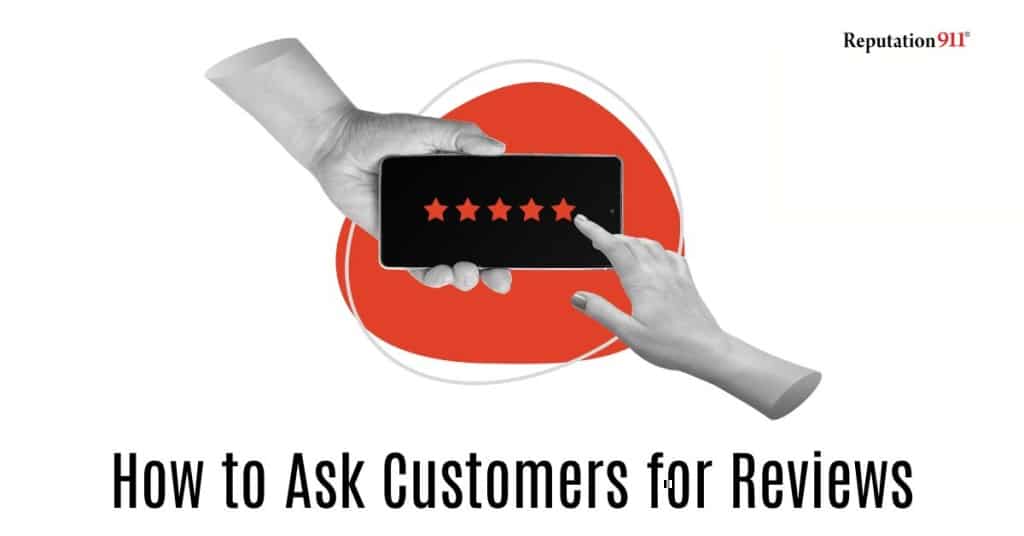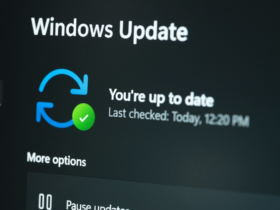In today’s competitive online marketplace, businesses depend on positive reviews to truly thrive. If your business lacks glowing feedback, earning more is a critical part of successful review management. For many business owners, asking for reviews can feel awkward, unnatural, and even pushy, but it doesn’t have to be that way! Here is everything you need to know about how to ask for a review (successfully):
Why Ask Customers for Reviews?
Customer reviews are important – they help shape a business’s online presence and success.
Here’s why you need to start asking for customers feedback:
Enhances Revenue
Positive reviews can significantly boost sales. Businesses with an average star rating of 4 or higher generate 32% more revenue than those with lower ratings. (WiserNotify)
Improves Local SEO Rankings
Reviews are a crucial factor in local search engine optimization (SEO). Google considers both their quantity and quality when determining local search rankings. More positive feedback can lead to better visibility in local search results.
Plus, high quality, positive reviews can help suppress negative content about your business.
Influences Consumer Decisions
A vast majority of consumers rely on reviews before making a purchase. Specifically, 97% of consumers report that they influence their purchasing decisions. (Website Builder)
Builds Trust and Credibility
Potential customers often trust peer reviews over brand messaging. 84% of consumers trust online reviews as much as personal recommendations, highlighting the importance of authentic customer feedback. (Reviews on My Website)
Related: Learn more about the importance of authenticity in marketing.
Encourages Customer Engagement
Actively requesting reviews shows customers that their opinions are valued, fostering a sense of engagement and loyalty. This practice not only provides valuable insights for business improvement but also strengthens customer relationships.
Customers Are Likely to Leave a Review if You Ask
Yes, feedback itself is important, but the key here is in the asking. Many customers are willing to share their experiences but simply need a little nudge. Studies show that around 87% of consumers will leave a review for a business if asked. Making a simple, friendly request can significantly increase the volume of feedback for your business.
How to Ask for Reviews:
Gathering reviews from customers, clients, and even vendors can be straightforward and natural with the right approach. Here’s how to request feedback effectively across various platforms:
In person
Asking for reviews in person can be intimidating, especially for small business owners and their employees. But, this can be highly effective, especially after a positive customer interaction.
Wait for a moment when the customer expresses satisfaction, then kindly ask for a review. Keep the conversation light and avoid pushing too hard.
Tips:
- Strike up conversations with happy customers and gauge their mood. Avoid asking customers who appear unhappy, and only ask once.
- Place QR codes linking to your review page in visible areas, like the counter, for easy access.
- If you don’t have a QR code, you can still direct them to your Google Reviews or TripAdvisor page. Just make sure they know where to go!
Example Script:
“We’re so glad you enjoyed your experience! If you have a moment, we’d love to hear your thoughts in an online review. You can just scan this QR code—it takes you right to our page!”
Over the phone
If your business involves interacting with customers over the phone, you can still ask them for reviews. This is similar to the ‘in-person’ advice, though it may be a bit harder to judge their mood on the phone.
Tips:
- Only ask for feedback when the customer seems genuinely happy.
- Guide them to your review page if needed.
Example Script:
“Thank you so much for your feedback! It’s great to hear you’re happy with our service. If you have a moment after this call, would you mind sharing your experience in an online review? You can go directly to our review page or I can send you the link if that’s easier!”
Through email
Email is a convenient way to reach customers and prompt them for reviews. Direct emails with personal touches from your team members can feel more sincere. Consider segmenting your email list to make each message as relevant as possible.
Tips:
- Personalize each email whenever possible.
- Keep the email short and friendly, with a clear link to your review page.
Example Script:
Subject: “We’d Love to Hear from You!”
Hi [Customer Name],
Thank you for choosing [Your Business]! We hope you’re enjoying your [product/service]. If you’re satisfied, would you mind taking a moment to share your experience in a quick online review? Your feedback helps others discover us and make informed choices! You can leave your review here: [Link to Review Page].
Thank you for being a valued customer!
Best regards, [Your Team Member’s Name]
Via text
If you’re communicating with customers through text message, consider asking them for a review that way. Send a personal message or set up automated SMS review requests after purchases.
Tips:
- Keep the tone conversational.
- Include a direct link for convenience.
Example Script:
“Thanks for choosing [Your Business]! We’d love to hear your feedback—just click this link to leave a quick review: [Link]. We appreciate your time!”
Post-purchase
For e-commerce stores, adding a thank-you card with a QR code for reviews in the product packaging is a great touch. You can also send post-purchase emails to request feedback after they’ve had time to use the product.
Tips:
- Include a QR code with a friendly thank-you note in shipped packages.
- Send follow-up emails after they’ve had a chance to try the product.
Example Script:
“We hope you’re enjoying your new [product]! When you have a moment, we’d love to hear your thoughts—scan this QR code or click this link [Link to Review Page] to leave a quick review. Thanks for being part of our community!”
On your website
Create a dedicated page on your website to make it easy for customers to leave feedback. You can also showcase existing positive reviews to encourage new ones.
Tips:
- Add a clear “Leave a Review” call-to-action on your homepage.
- Display existing reviews to encourage new contributions.
Example Page Content:
“Enjoyed your experience with us? We’d love to hear from you! Click here to leave a review and share your experience with others.”
On social media
On social media, your audience is already engaged with your brand. This makes it an ideal space to encourage customers to leave reviews! Post links to your review page or share positive feedback to prompt others to contribute.
Tips:
- Share links to your review page in posts.
- Highlight positive testimonials to inspire others to share their feedback.
- If a customer leaves a glowing comment on your post, consider replying to their comment and asking for a review. Only do this if it feels natural, and don’t do this to every comment.
Example Post:
“Love our service? We’d love to hear from you! Leave a review and help others learn about our business. Just click here: [Link]. Thank you!”
Asking clients for reviews
After completing a project for a client, send them a personalized email to request a review or testimonial. Timing is essential here. Ask soon after project completion, when the client likely feels positive about the experience.
Tips:
- Make it personal and thank them for their business.
- Be specific about where you want them to leave feedback.
Example Script:
Hi [Client Name],
It was a pleasure working with you on [Project Name]. We’re thrilled to have been part of it! If you’re happy with our work, would you mind sharing your experience in a quick online review? It would mean a lot to us. You can leave your feedback here: [Link to Review Page].
Thanks again for choosing us!
Best, [Your Name]
Asking vendors for reviews
Just as you rely on vendors, they rely on you. Vendors can offer valuable insights into your professionalism and reliability. After a successful collaboration, consider asking for a testimonial to strengthen your online reputation.
Tips:
- Be appreciative and acknowledge the partnership.
- Specify how their feedback can help both of your businesses.
Example Script:
Hi [Vendor Name],
We’ve enjoyed partnering with you and appreciate your hard work. Would you be open to sharing a review of your experience with us? A few words from a trusted partner like you would go a long way in helping us reach new clients. Here’s a link if you’d like to leave a review: [Link to Review Page].
Thanks for your continued partnership!
Warm regards, [Your Name]
Do’s and Don’ts When Requesting Reviews
Asking for reviews can be incredibly effective, but you must go about it in the right way.
Here’s the top do’s and dont’s when asking for reviews:
Do: Ask at the right time
The goal of asking for reviews is to get positive feedback, so the timing matters. If talking directly to a customer, ask after the customer has had a positive experience or expressed satisfaction in your products or services. This is when they’re most likely to leave favorable feedback.
In e-commerce settings, it’s best to send all customers a request after they purchase a product. Remember, you may need to follow up with them after they have had time to use the product.
Do: Personalize your request
Personalized messages feel more genuine and are more effective in encouraging responses. Whenever possible, mention the customer’s name, refer to their purchase, or acknowledge something specific about their experience. A personal touch shows customers that you value their feedback.
Do: Show appreciation
When asking for a review, express your gratitude for the customer’s time and feedback. Let them know how valuable their input is for your business. A simple “thank you” makes customers feel valued and appreciated, increasing the chances they’ll leave a thoughtful comment.
Do: Use multiple channels
Request reviews through a mix of platforms, such as email, text, and social media, to reach different customer preferences. Some people prefer emails, while others respond better to texts or social media reminders. This multi-channel approach increases the likelihood that they’ll engage.
At the same time, set up listings (like a Google Business Profile) on multiple review sites for maximum visibility.
Related: Consider getting Google Guaranteed to help your local business stand out in search results.
Do: Keep it short and clear
Your review request should be straightforward. Let customers know exactly what you’re asking and how they can complete it quickly. A short, clear message with a direct link to the review page makes it easy and more likely that they’ll respond.
Don’t incentivize
Offering rewards in exchange for reviews may seem like a quick way to gather feedback. However, this can have serious consequences.
Most review platforms strictly prohibit incentivizing reviews. Violating these policies can result in penalties, including a ban on your business profile.
Another downside is that customers tend to leave lower quality reviews if they’re just doing it to get their reward. Ideally, you want them to write about their experience instead of just leaving a quick star rating. More detailed reviews help other customers make informed decisions.
Don’t buy reviews
Buying reviews is not only against platform policies, but it’s also dishonest. Fake reviews damage trust and can hurt your brand’s credibility in the long run. Customers are increasingly aware of them, and many can spot them. The risk simply is not worth the reward here.
Don’t avoid responding
Whether feedback is positive or negative, responding shows that you value your customers’ experiences and feedback. Ignoring feedback, especially negative reviews, can make you seem indifferent.
On the other hand, a thoughtful response shows you value every customer’s opinion and want to improve your business. While not every review is accurate, make sure to thank customers for leaving constructive criticism.
Learn more about responding to reviews here.
Don’t force it
Make sure to ask for reviews in a natural, genuine way. People want to support businesses they connect with. However, if they sense desperation or feel pressured, they’re less likely to leave a review.
A genuine, friendly request will likely get you a positive response. So, keep your approach relaxed and avoid sounding pushy.
Don’t make it difficult
Customers are more likely to leave reviews if the process is straightforward. If it’s complicated or time-consuming, they’re less likely to do it.
Make sure you’re including direct links to your review page, and give clear instructions on where and how to leave a review. The easier you make it, the more likely they are to follow through.
Don’t apologize for asking
Remember, customers are often happy to leave positive feedback when asked. Most successful businesses ask for them, so you should too! Reviews are especially valuable for small businesses in need of word-of-mouth marketing. Plus, they help potential customers make decisions and provide your business with valuable feedback.
So, ask confidently and avoid apologies; chances are, they’ll appreciate the opportunity to share their experience.
Conclusion: Start Earning Better Reviews Today
Online reviews play a critical role in your overall business reputation. They help you earn trust, attract new customers, and thrive in today’s competitive market.
If your business is struggling with negative or fake reviews, Reputation911 has you covered. We specialize in monitoring reviews, improving star ratings, highlighting positive experiences, and mitigating the impact of harmful feedback.
Ready to take control of your business reputation? Contact us today for a free consultation.
William DiAntonio is the Founder & CEO of Reputation911, a reputation management firm he founded in 2010 that has earned the trust of its clients for over a decade by helping individuals, businesses and brands control their online search results.















